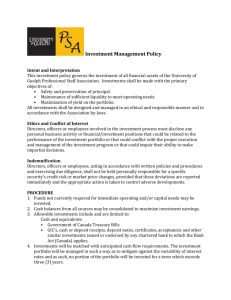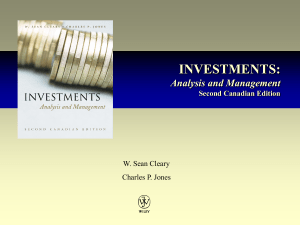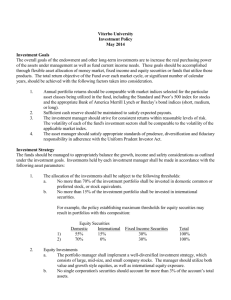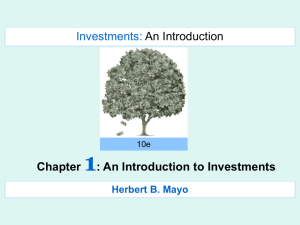Investments - Endowment Funds
advertisement
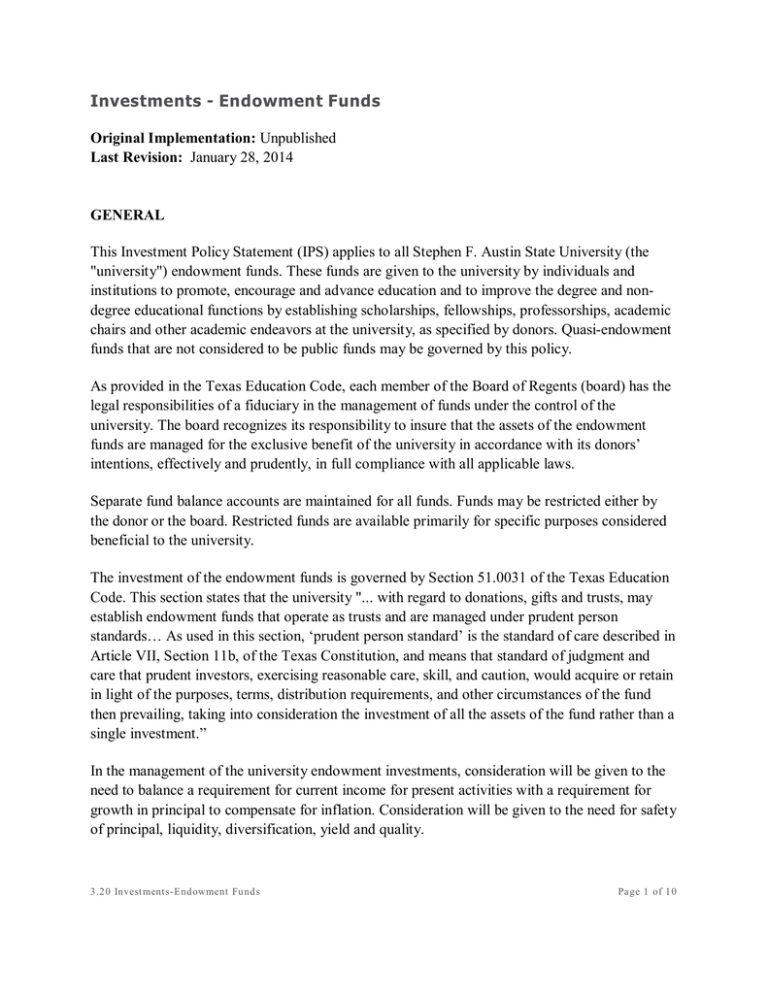
Investments - Endowment Funds Original Implementation: Unpublished Last Revision: January 28, 2014 GENERAL This Investment Policy Statement (IPS) applies to all Stephen F. Austin State University (the "university") endowment funds. These funds are given to the university by individuals and institutions to promote, encourage and advance education and to improve the degree and nondegree educational functions by establishing scholarships, fellowships, professorships, academic chairs and other academic endeavors at the university, as specified by donors. Quasi-endowment funds that are not considered to be public funds may be governed by this policy. As provided in the Texas Education Code, each member of the Board of Regents (board) has the legal responsibilities of a fiduciary in the management of funds under the control of the university. The board recognizes its responsibility to insure that the assets of the endowment funds are managed for the exclusive benefit of the university in accordance with its donors’ intentions, effectively and prudently, in full compliance with all applicable laws. Separate fund balance accounts are maintained for all funds. Funds may be restricted either by the donor or the board. Restricted funds are available primarily for specific purposes considered beneficial to the university. The investment of the endowment funds is governed by Section 51.0031 of the Texas Education Code. This section states that the university "... with regard to donations, gifts and trusts, may establish endowment funds that operate as trusts and are managed under prudent person standards… As used in this section, ‘prudent person standard’ is the standard of care described in Article VII, Section 11b, of the Texas Constitution, and means that standard of judgment and care that prudent investors, exercising reasonable care, skill, and caution, would acquire or retain in light of the purposes, terms, distribution requirements, and other circumstances of the fund then prevailing, taking into consideration the investment of all the assets of the fund rather than a single investment.” In the management of the university endowment investments, consideration will be given to the need to balance a requirement for current income for present activities with a requirement for growth in principal to compensate for inflation. Consideration will be given to the need for safety of principal, liquidity, diversification, yield and quality. 3 .2 0 Invest ments-End owment Fu nd s Pa ge 1 of 1 0 The overall objective of the IPS is to assure that the university’s endowment funds are invested in a manner to achieve as high a level of return as can reasonably be expected to be achieved given the primary objective of safety and preservation of principal. The IPS clearly and concisely states the responsibilities of all parties involved with the endowment funds. The IPS will assist the board, the finance/audit committee ("committee") and the university administration in effectively communicating with and monitoring the investment manager(s) and the investment firm(s) that will be engaged from time to time to facilitate the management of the endowment assets of the university. It states the boards' attitudes, guidelines and objectives in the investment of the endowment assets. RESPONSIBILITIES The university acknowledges that the ultimate responsibility for satisfactory investment results rests with the board. The board believes that this responsibility is best discharged by delegating certain authority to the university administration and by appointing one or more investment management organizations to assume certain responsibilities. The specific responsibilities of the board in the investment process include and are limited to developing a sound and consistent investment policy, developing sound and consistent investment policy guidelines, establishing reasonable investment objectives, allocating the endowment assets between equity and fixed-income investments, and other investment mediums which it may deem appropriate and prudent, communicating clearly the major duties and responsibilities of those accountable for investing the endowment assets and achieving investment results, evaluating performance results, and abiding within all applicable laws, including conflict of interest provisions therein. The vice president for finance and administration (vice president) and director of financial services are designated as the investment officers for the university. As such, the vice president or designee are responsible for accounting for investments, monitoring and evaluating performance results, and ensuring that policy guidelines are being adhered to and investment objectives are being met. In addition, the vice president is responsible for the purchase, sale, assignment, transfer and management of investments, for communicating with investment managers, brokers and dealers, for compiling performance results, and for determining the proper distribution of investment returns to the various accounts. The vice president is also responsible for determining the appropriate distribution of income in accordance with the distribution policy in the distribution policy section. The vice president, or designee, will submit an annual investment perspective to the Board of Regents. The vice president may establish an investment committee. The committee may review investment reports, monitor investment activity or review and revise qualified investment 3 .2 0 Invest ments-End owment Fu nd s Pa ge 2 of 1 0 brokers that are eligible to serve in an investment capacity for the university. The chair of the Board of Regents may designate a board member to serve as a liaison on the investment committee. INVESTMENT POLICY The board believes that the endowment assets should be managed in a way that reflects the application of sound investment principles. The board adheres to the traditional capital market theory that maintains that over the long term, the risk of owning equities should be rewarded with a somewhat greater return than available from fixed-income investments. This reward comes at the expense of higher volatility of returns and more exposure to market fluctuations than with fixed-income investments. Fixed-income investments provide a more predictable return and higher current income than do equities. Thus assets should be allocated between fixed-income investments, equities, and alternative investments in such a manner as to provide for current income while providing for maintenance of principal in real terms. Avoiding large risks is essential. The university is willing to trade off some potential opportunities for gain from high-risk investments (with high loss potential) by assuming a moderate-risk posture in order to have a more stable positive return. This may result in sacrificing some potential opportunities for gain during rising markets in order to avoid large short term declines in market value during falling markets. Since the university is adverse to large downward fluctuations in the value of its investments resulting from volatile market value fluctuations, such year-to-year volatility should be minimized. INVESTMENT POLICY GUIDELINES For the purpose of this policy, all individual securities which use long-term credit ratings must be rated the equivalent of “BBB” or better by a nationally recognized credit rating service. Securities using short-term credit ratings must be rated at least A-2, P-2, F-2 or the equivalent by a nationally recognized credit rating service. The following categories of securities are permissible investments: a. Direct obligations of the United States government or its direct agencies. b. Direct obligations of federally-sponsored agencies in accordance with the above paragraph. c. Taxable obligations of U.S. state and local governments in accordance with the above paragraph. 3 .2 0 Invest ments-End owment Fu nd s Pa ge 3 of 1 0 d. United States dollar denominated bonds, debentures, or commercial paper and convertible securities issued by corporations in accordance with the above paragraph. e. Common stock and preferred stock issued by United States domiciled corporations and common stocks of foreign companies listed on the major U.S. or foreign security exchanges. f. Certificates of Deposit issued by federally insured state banks, federally insured savings and loan associations and saving banks or federally insured credit unions. Amounts over the insurance limit of the institutions must be secured by pledged securities. g. Bankers’ acceptances accepted by a bank organized and existing under laws of the United States or any state in accordance with the above paragraph. h. Money Market Mutual Funds. Funds must be registered with the Securities and Exchange Commission, have a maximum dollar weighted average maturity of no longer than l3 months, and be no-load funds. Funds must have assets consisting of securities described in the paragraphs above and seek to maintain a stable net asset value of $1.00 per share (or unit). i. Direct Security Repurchase Agreements. Direct Repos must be fully secured (collateralized) by securities authorized under the sections (a) through (f) above. Such collateral must be held by a third party. All agreements will comply with Federal Reserve Bank guidelines. j. Shares of investment companies as defined by the Investment Company Act of l940. These companies include both closed-end investment companies and open- end investment companies (mutual funds). Shares in these companies may be purchased if they own securities described in sections (a) through (h) above. k. Shares of Exchange Traded Funds, known as ETFs, are permissible investments under this section. l. Certain types of transactions and purchase of certain types of securities are specifically prohibited by this policy. Commodity trading including all futures contracts, purchasing of letter stock, short selling, option trading, and margin trading are specifically prohibited. Neither tax-exempt debt of state and local governments, private placements, nor guaranteed investment contracts may be purchased. No investments will be made in derivative products as defined by the Financial Accounting Standards Board in Statements of Financial Accounting Standards, No. 133. Collateralized mortgage obligations that do not pass the Federal Financial Institution’s Examination Council test may not be purchased. m. Assets and/or funds reportable within the scope of the university’s annual financial report may not be invested in or used to purchase securities, including obligations, of a private corporation or other private business entity that owns 10% or more of a corporation or business entity which records or produces any song, lyrics or other musical work that explicitly describes, glamorizes or advocates: (1) acts of criminal violence, including murder, assault, assault on police officers, sexual assault, and robbery; (2) necrophilia, bestiality, or pedophilia; (3) illegal use of controlled substance; (4) criminal street gang 3 .2 0 Invest ments-End owment Fu nd s Pa ge 4 of 1 0 n. o. p. q. activity; (5) degradation or denigration of females; or (6) violence against a particular sex, race, ethnic group, sexual orientation, or religion. No more than six percent (6%) of the portfolio, including convertible securities, can be invested in any one company. This will be measured on a cost basis. No more than ten percent (10%) of the portfolio can be invested at any time in one company based on the market value of the stock and portfolio. This section is not applicable to investments in U.S. government securities. No more than fifteen percent (15%) of the portfolio can be invested in any one industry sector, as defined by Standard and Poor’s broad categories, based on the cost value of the portfolio. No more than thirty percent (30%) of the portfolio can be invested in any one industry sector based on the market value of the portfolio. The holdings do not have to be invested in industry groups that represent a cross- section of the economy. Permitted alternative investments in the portfolio may include hedge funds, managed futures funds, private equity funds, or real estate. Investments in other strategies shall be reviewed and recommended by the investment officer prior to purchase. Permitted alternative investments in the Portfolio are limited to diversified commingled trust fund vehicles or limited partnerships offered through a third party distribution channel, such as what is offered through many broker- dealer firms. Mutual funds securities that are rated below A must comprise less than 1 percent of the holdings in the alternative portion of the endowment portfolio and must have a minimum B rating. Any investment vehicles where the portfolio’s liability can exceed the value of the portfolio’s investment are strictly prohibited. The portfolio shall emphasize investments in fund-of-fund vehicles that are diversified by investment style and typically utilize multiple investment managers within a fund. The portfolio, however, may invest in single manager funds, but these investments shall not comprise the majority of the investment. Permitted alternative investments in the portfolio are limited to investment vehicles that offer the ability for the portfolio to make contributions or receive distributions at least quarterly (but preferably monthly) without restriction or incurring additional fees. The maximum allocation to any one fund shall not exceed 25% of the total investment portfolio. If the allocation to alternative investments exceeds the limit at any point in time, the investment officer shall rebalance the allocation to the fund at the next opportunity when the fund permits liquidation of fund holdings. For the alternative portion of the portfolio, an allocation that exceeds 10% of the total endowment portfolio shall require approval of the investment officer and the investment committee. All of the equities purchased for the portfolio (based at market value) should have a minimum market capitalization of $250 million. The allowable range and target asset allocation for the endowment funds is: 3 .2 0 Invest ments-End owment Fu nd s Pa ge 5 of 10 Class Allowable Range Equities securities 0% - 70% Fixed income securities 0% - 60% Cash or cash equivalents 0% - 100% Alternative Investments 0% - 25% Target 55% 35% 0% 10% For the equity portion of the portfolio, the International Equities should represent at a maximum 30% and minimum 0%. For the fixed income portion of the portfolio, the asset mix should be: maximum U.S. government bonds 100%, minimum government bonds 0%, maximum corporate bonds 50%, minimum corporate bonds 0%, maximum cash 100%, minimum cash 0%. Gifts of individual securities will be liquidated or transferred to an equity fund manager currently employed by the university under the Use of Investment Firms section. The liquidation or transfer will take place as soon as possible. If liquidated, the proceeds will be invested in accordance with the allowable range and target asset allocation set forth in this policy. Exceptions to this policy are securities described by sections (a), (b) and (c) above. Such securities may be held so long as the asset allocation ranges are maintained. The policy in this section can be overridden by a written directive from a donor. The university will insure the safety of its invested funds by limiting interest rate, credit and foreign currency risks. Interest rate risk is the risk that changes in market interest rates will adversely affect the fair value of an investment. Generally, the longer the maturity of an investment the greater the sensitivity of its fair value to changes in market interest rates. The vice president may diversify investment maturity to limit interest rate risk. The average weighted duration of the portfolio should not vary from industry benchmarks by more than +/-20%. Credit risk is the risk that an issuer or counterparty to the investment will not fulfill its obligations to the holder of the investment. This is measured by the assignment of a rating by a nationally recognized statistical rating organization. To limit credit risk, this policy requires investments in US dollar denominated bonds, debentures, or commercial paper and convertible securities issued by corporations to be rated the equivalent of “BBB” or better using long-term ratings and at least A-2, P-2, F-2 or equivalent using short-term credit ratings. Foreign currency risk is the risk that changes in exchange rates will adversely affect the fair value of investment. In order to mitigate this risk, foreign investments are limited to a maximum of 30% of the portfolio. 3 .2 0 Invest ments-End owment Fu nd s Pa ge 6 of 10 USE OF INVESTMENT FIRMS The vice president or designee is responsible for the selection of brokers and dealers for the execution of security transactions and for the safekeeping of securities. Sales, purchases and exchanges will be transacted through well-capitalized, nationally recognized investment firms which are major participants in the equity and fixed-income markets. Firms should be selected to provide the maximum benefit to the university. The vice president may choose to use a request for proposals to select the firm or firms with which the university deals. Selection of outside investment managers will follow these guidelines: a. The vice president or designee, within statutory and other regulatory authority, may place selected funds of the university with investment managers outside the university for investment purposes. The investment of such funds will be subject to the provisions of this investment policy statement. The vice president or designee is authorized to negotiate with outside investment managers for the benefit of the university. b. Outside investment manager(s) will receive a copy of the IPS and a Letter of Instructions outlining investment instructions and asset allocation parameters expressed in writing by the vice president or designee. The Letter of Instructions will state return objectives that are reasonable and achievable within the guidelines provided herein. These return objectives should be achieved over a reasonable time frame, thus it is not necessary for the outside manager(s) to exceed the return expectations each quarter. In addition, each outside investment manager must execute a written statement to the effect that the registered principal of the organization has received and thoroughly reviewed the investment policy of the university. The statement must also acknowledge that the organization has implemented reasonable procedures and controls in an effort to preclude imprudent investment activities. c. Consistent with this investment policy statement and their Letter of Instruction, the outside investment manager(s) will be responsible for making decisions on a discretionary basis. This includes buy, hold, sell and timing decisions. The outside manager(s) must make responsible decisions in the selections of specific securities and the general timing of purchases and sales necessary to achieve a satisfactory overall return for the assets. d. Outside manager(s) will invest only into the security class(es) for which they were retained to manage. The manager(s) have discretion to place funds into cash, however, their performance will be measured against an index which measures their security class without deducting the cash position. The overall portfolio and the individual managers will be evaluated on a periodic basis using industry benchmarks. 3 .2 0 Invest ments-End owment Fu nd s Pa ge 7 of 10 The annualized Alpha should exceed both individual managers’ and total portfolio fees. Alpha measures the excess return for the amount of risk taken. Portfolio turnover will be monitored. If the performance results of the portfolio meet the objectives stated herein, the rate of turnover in the portfolio will not be an evaluative factor. However, a portfolio turnover higher than the average of similar fund managers is considered a negative. Files will be maintained on investment firms with which the university deals. The files will contain information that supports the financial stability of the firms. These files will be updated annually. A list of approved brokers and firms will be maintained and changes will be approved by the Board of Regents. DISTRIBUTION POLICY The spending policy should balance the long-term objective of maintaining the purchasing power to the endowment funds with the goal of providing a reasonable, predictable, stable, and sustainable level of income to support current needs. At the end of the investment year, in consultation with the investment manager, the investment officer will review the total return on the endowment accounts and recommend an annual distribution. The target distribution will be between 4% and 5%. The investment officer will recommend an amount up to 5.00% of the average invested balance for the purposes delineated in the endowment memorandum of understanding. If returns permit, an amount equal to the rate of inflation will be added back to each endowment principal balance. If there are positive total returns beyond the inflation rate, then the investment officer will recommend that this amount be added to a contingency reserve that may be distributed during years of poor investment performance as determined by the officer. When the contingency reserve has reached a balance in excess of two years of normal distributions, the investment officer may recommend that additional distributions be made from the contingency reserve. PERFORMANCE EVALUATION The vice president will submit quarterly reports to the board on the performance of the investment portfolio. The reports will disclose the book value and market value of the portfolio at the beginning and ending of the reporting period by the type of asset and fund type invested. The reports will disclose the realized and unrealized gains/losses on the portfolio for the reporting period. Additions and changes in the market value of the portfolio during the period will be reported. The reports will show the pooled fund value as well as individual assets by fund type. The reports will state the maturity date of each asset that has a maturity date. The total return on the portfolio, on each asset class and for each manager will be reported. The performance of the total portfolio, each asset class and each manager will be compared to appropriate benchmarks and included in the quarterly reports to the board. The report will contain sufficient information for the board to determine if actions should be taken to correct any deficiencies that may exist. 3 .2 0 Invest ments-End owment Fu nd s Pa ge 8 of 10 CONFLICTS OF INTEREST Members of the board are frequently persons of wide-ranging business interests. Therefore, a prudent, independent investment decision process may result in investments in firms or organizations with which a member of the board is affiliated. Affiliation shall be interpreted within this section to mean an employee, officer, director, or owner of five percent or more of the voting stock of a firm or organization. The investment staff or an unaffiliated investment manager may invest in such securities. However, the following restrictions shall apply a. a member of the board shall not direct nor participate in the decision to purchase or sell securities of a firm with which such member is affiliated; and b. investments will not be purchased from or sold to a member of the board. DISCLOSURE REQUIREMENTS Disclosure Requirements for Outside Financial Advisors External financial advisors and service providers shall comply with Texas Government Code Chapter 2263, Ethics and Disclosure Requirements for Outside Financial Advisors and Service providers. Disclosure Requirements for Investment Officers Pursuant to Texas Government Code Sec. 2256.005(i), an investment officer of an entity who has a personal business relationship with a business organization offering to engage in an investment transaction with the entity shall file a statement disclosing that personal business interest. An investment officer who is related within the second degree by affinity or consanguinity, as determined under Chapter 573, to an individual seeking to sell an investment to the investment officer's entity shall file a statement disclosing that relationship. A statement required under this subsection must be filed with the Texas Ethics Commission and the governing body of the entity. For purposes of this subsection, an investment officer has a personal business relationship with a business organization if: 1. the investment officer owns 10 percent or more of the voting stock or shares of the business organization or owns $5,000 or more of the fair market value of the business organization; 2. funds received by the investment officer from the business organization exceed 10 percent of the investment officer's gross income for the previous year; or 3. the investment officer has acquired from the business organization during the previous year investments with a book value of $2,500 or more for the personal account of the investment officer. 3 .2 0 Invest ments-End owment Fu nd s Pa ge 9 of 10 AUDITS The Department of Audit Services of the university shall include endowment assets as a component of its annual audit risk assessment. If the department determines that the endowment assets meet its risk assessment criteria, audit services may perform an annual audit of the endowment assets to ensure compliance with the endowment investment policy. Cross Reference: Tex. Educ. Code § 51.0031; Tex. Gov’t Code Ch. 573, § 2256.005, Ch. 2263; 15 U.S.C. §§ 80a-1 – 80a-64; Tex. Prop. Code Ch. 163 Responsible for Implementation: Vice President for Finance and Administration Contact for Revision: Vice President for Finance and Administration Forms: None Board Committee Assignment: Finance and Audit 3 .2 0 Invest ments-End owment Fu nd s Pa ge 10 of 10


